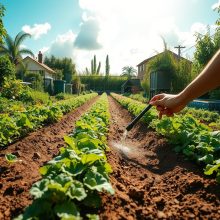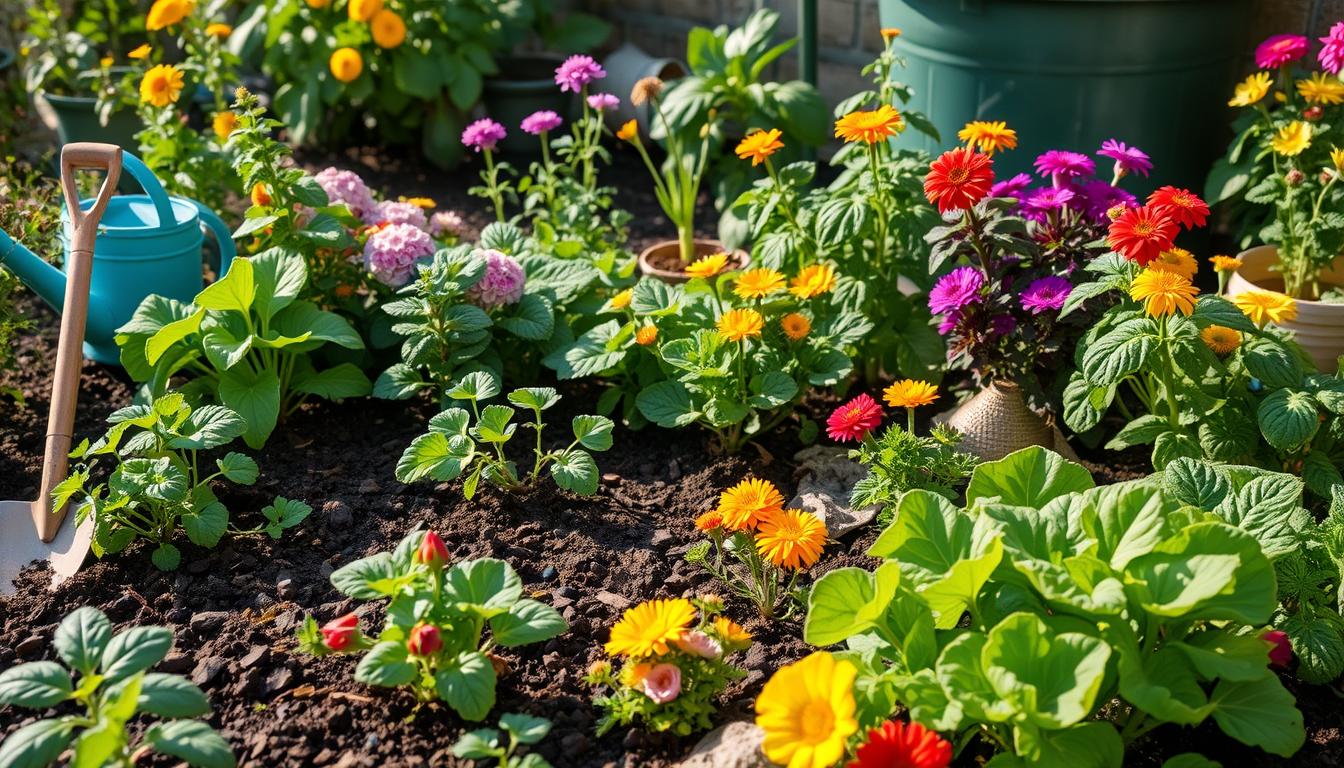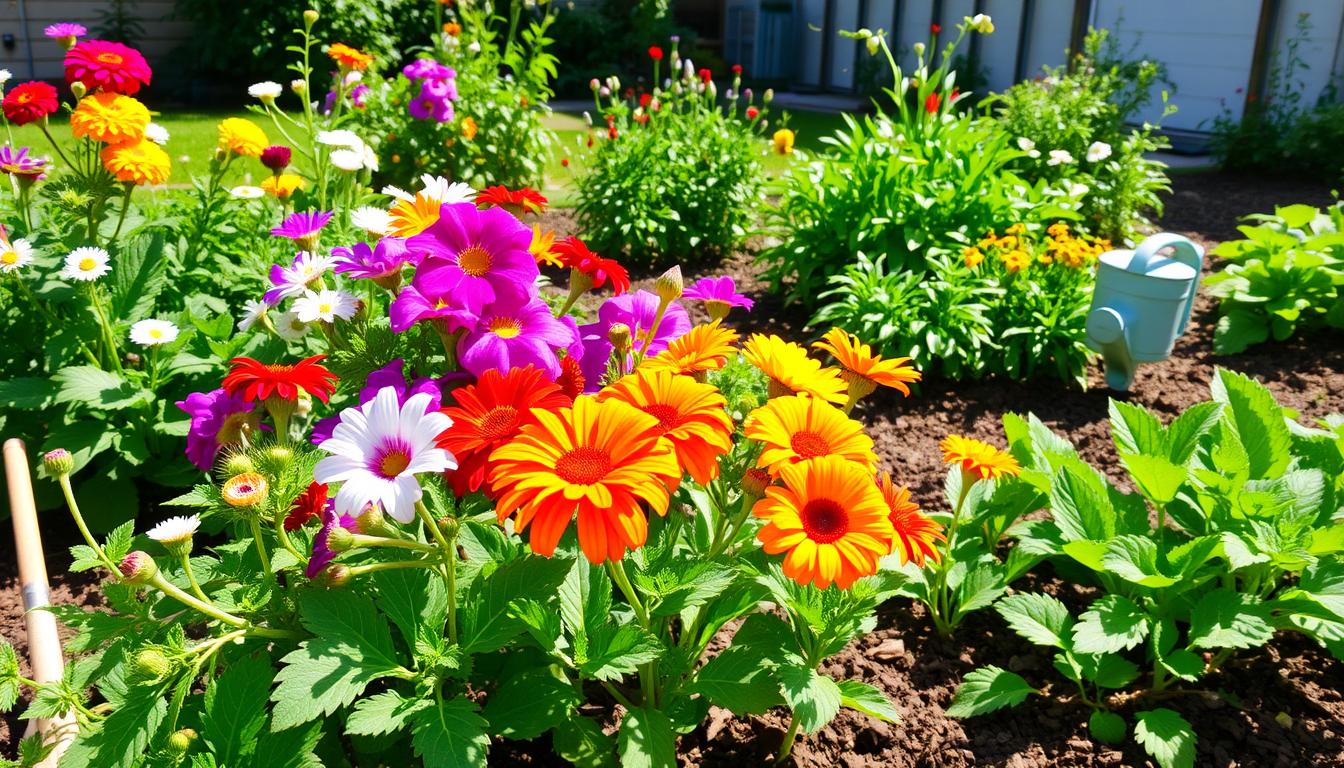Discover the Surprising Benefits of Mulching
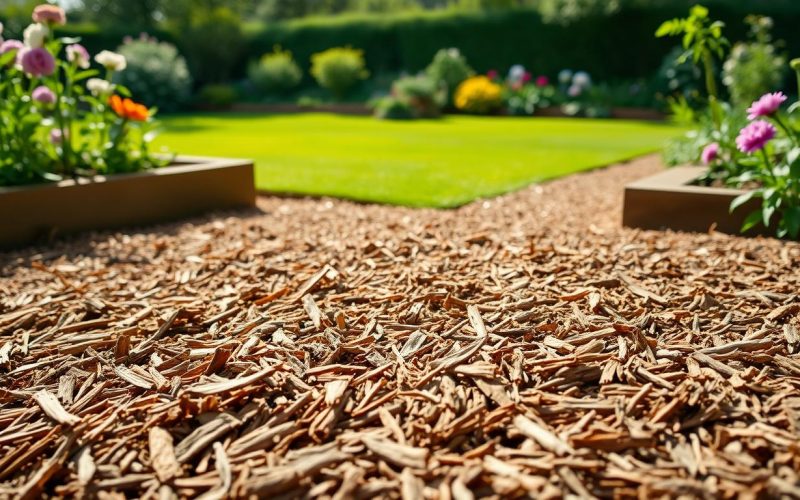
Gardeners and landscapers know mulching is a game-changer. It does more than just cover the ground. Mulching protects plant roots and improves soil quality, changing how we garden.
Learning about mulch opens up new possibilities for better landscapes. Whether you’re a pro or a hobbyist, using mulching techniques can make plants healthier and gardens more sustainable.
Key Takeaways
- Mulching provides comprehensive protection for plant ecosystems
- Reduces water evaporation and maintains soil moisture
- Suppresses weed growth naturally
- Regulates soil temperature effectively
- Enhances overall landscape aesthetic appeal
What is Mulching and Why is it Important?
Mulching is a key gardening technique that can greatly improve your landscape. It involves covering soil with a protective layer. This layer brings many benefits, beyond just making your garden look good.
Mulching’s main goal is to protect and care for your garden’s ecosystem. It helps improve soil quality, keeps moisture in, and supports plant growth.
Definition of Mulching
Mulching means spreading a protective material over soil in gardens and landscapes. This layer shields the soil, offering many benefits for plants and soil health.
Types of Mulch
There are various mulch types, each with its own benefits. The main categories are:
- Organic Mulch: Natural materials like wood chips, bark, straw, and compost
- Mineral Mulch: Stones, gravel, and rock materials
- Synthetic Mulch: Landscape fabrics and plastic films
Common Materials Used
When picking mulch, gardeners have many organic options. Some favorites include:
- Pine bark
- Cedar chips
- Leaf mold
- Grass clippings
- Straw
Each material has its own benefits. They help gardeners create healthier, more durable landscapes with the right mulching techniques.
Enhancing Soil Health and Structure
Mulching is key to making garden soil top-notch. It does more than just cover the ground. It creates a lively ecosystem that helps plants grow and makes the soil stronger.
Organic mulch is a great way to make soil more fertile. As it breaks down, it adds important nutrients to the soil. This makes the soil rich and good for plants.
Improving Soil Fertility
Mulch is full of nutrients that help the soil. Materials like:
- Bark chips
- Compost
- Leaf mold
- Straw
They slowly add minerals and organic matter to the soil. This makes the soil better, holds more water, and feeds plants well.
Promoting Beneficial Microorganisms
Mulch is great for tiny soil helpers. These tiny workers help break down organic matter, improve air in the soil, and help plant roots. Keeping mulch on the soil helps plants grow strong.
Long-term mulching makes the soil better in many ways. It helps with drainage, reduces soil compaction, and makes the soil quality better. Gardeners who mulch are investing in a healthy and productive garden.
Water Conservation with Mulching
Gardeners looking for green solutions find mulching to be a game-changer. It’s not just about covering the ground. Mulch is a key to keeping plants healthy and water in the soil.
Mulching is a top choice for saving water in gardens. It acts as a shield, stopping water from evaporating. This keeps the soil moist, which is good for plants.
Reducing Water Loss
Landscapers know mulch is great at keeping soil wet. Studies show it can hold a lot of water:
- Mulched soil stays up to 90% humid
- Soil without mulch holds about 20% moisture
- Using mulch can cut water use by 25-50%
Efficient Water Management Strategies
In dry times, mulch really helps. It stops water from evaporating fast. This lets plants use water longer, making them stronger during droughts.
Homeowners can make their gardens water-smart with mulching. Choosing the right mulch and using it right makes saving water easy and effective.
Weed Control Made Easy
Gardeners and landscapers have always looked for ways to stop unwanted plants. Mulch is a strong tool for weed control, offering a natural way to keep gardens weed-free. Studies show that good mulching can stop up to 80% of weeds from growing.
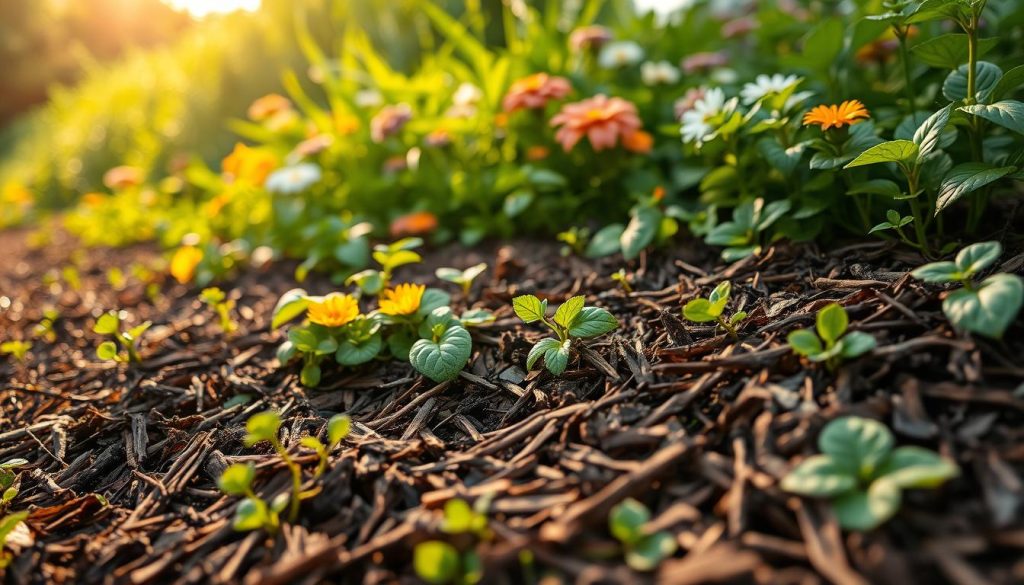
Mulch works by blocking weeds from growing. It stops sunlight and weed seeds from germinating. This makes taking care of gardens easier and less work.
How Mulch Suppresses Weeds
- Creates a physical barrier preventing weed seed germination
- Blocks sunlight essential for weed growth
- Reduces soil temperature fluctuations
- Limits available space for weed root development
Types of Mulch for Effective Weed Management
There are many mulches, each with its own weed-fighting power. Organic mulches like wood chips, straw, and bark are great for covering the ground and improving soil. Inorganic mulches like landscape fabric and stone can block weeds for a long time.
- Organic mulches: Wood chips, straw, bark
- Inorganic mulches: Landscape fabric, stones
- Recommended depth: 2-4 inches for maximum effectiveness
Using mulch the right way can make garden care easier. It cuts down on the need for harmful chemicals and helps gardens stay healthy.
Temperature Regulation in the Garden
Mulching is a great way to protect plants from extreme temperatures. It helps create a stable place for plants to grow all year. Mulch acts like a shield for roots, keeping them safe from bad weather.
Mulching does more than just cover the ground. It helps control temperature, which is key for plant health and survival.
Protecting Plant Roots from Extreme Conditions
Good mulching keeps plant roots in a steady environment by:
- Stopping sudden temperature changes
- Keeping soil warm in winter
- Keeping soil cool in summer
- Lessening stress on roots
Seasonal Temperature Management
Different mulches offer different levels of protection. Organic mulches like wood chips and bark are top choices. They keep soil temperature steady, which is good for roots and the garden.
Mulch creates a stable microclimate. This helps plants get through frost and hot days. Gardeners can grow plants longer and keep them safe with the right mulching.
Boosting Aesthetic Appeal of Landscapes
Mulch turns simple landscapes into beautiful outdoor spaces. It’s more than just ground cover. It’s a design tool that makes gardens look amazing. Mulch gives a clean, polished look that boosts any outdoor area’s beauty.
Mulch helps create harmony and contrast in gardens. Different types of mulch match your landscape’s style and plants.
Enhancing Visual Interest
Mulch comes in many colors and textures. It can change garden spaces:
- Dark brown mulches create rich, elegant backgrounds for green plants
- Light-colored mulches brighten shaded garden areas
- Textured mulches add depth and dimension to landscape beds
Choosing the Right Mulch for Curb Appeal
Choosing the right mulch depends on your landscape’s design. Organic mulches like bark chips are great for natural styles. Crushed stone mulches are perfect for modern looks. The right color and material can make your property look better.
Experts say to match mulch with your home and plants. This creates a beautiful, intentional design. It increases your property’s value and appeal.
Erosion Control Benefits
Garden mulch does more than just look good. It’s a key defense against soil erosion. This protects your garden’s most precious asset – its soil. Without it, rain and wind can quickly wash away the topsoil, leaving your garden bare and unproductive.
For gardens with slopes or heavy rainfall, mulching is a game-changer. It acts as a shield, soaking up raindrops and slowing down water flow. This keeps your soil safe and your garden healthy.
How Mulch Prevents Soil Erosion
- Absorbs rainwater impact, minimizing soil displacement
- Creates a protective layer over vulnerable soil surfaces
- Reduces water velocity during heavy precipitation
- Helps stabilize soil particles and maintain ground structure
Sustaining Garden Integrity
Using mulch the right way keeps your garden intact. It stops soil from washing away. Different mulches offer different levels of protection. Organic mulches like wood chips and straw are top choices for a strong, resilient garden.
To get the most out of mulching, apply a 2-3 inch layer. This covers the ground fully and protects your plants and soil.
The Role of Mulch in Pest Management
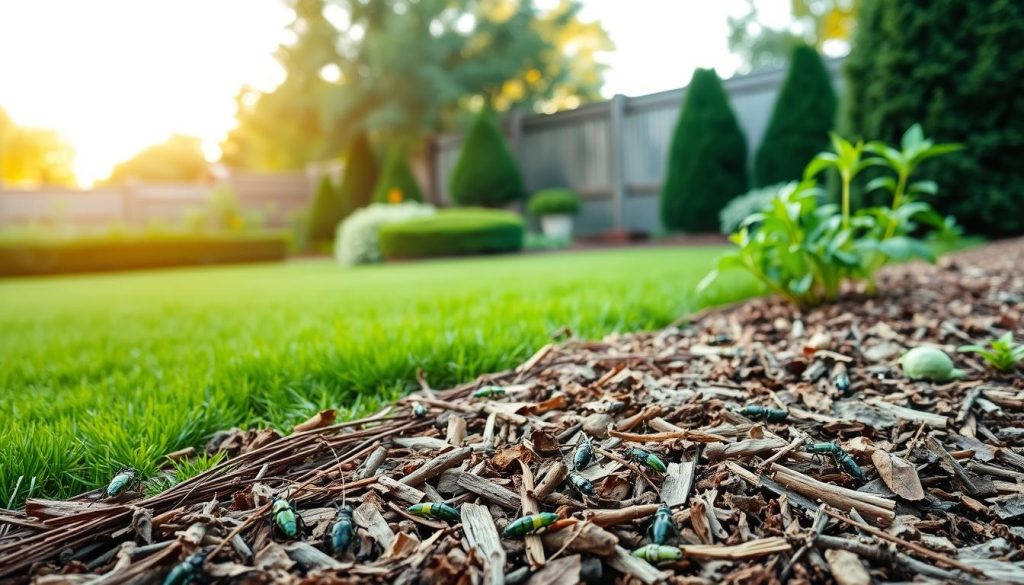
Gardeners looking for natural ways to control pests find organic mulch very helpful. Mulch does more than just protect the soil. It offers a smart way to fight garden pests without using harmful chemicals.
Organic mulch acts as a strong defense in gardens. Different types of mulch create barriers that keep away bad insects. At the same time, they help good wildlife thrive.
Natural Pest Deterrent Strategies
- Cedar mulch repels many harmful insects with its natural oils
- Pine needle mulch makes it hard for slugs and snails to move
- Wood chip mulches disrupt pests’ ability to move and breed
Encouraging Beneficial Insects
Smart mulching helps attract good bugs. Organic mulch creates homes for ladybugs, ground beetles, and spiders. These bugs help control pests naturally.
By choosing the right mulch, gardeners can create a balanced garden. This balance helps reduce pest damage naturally. The trick is to pick mulch that fits your garden’s needs.
- Keep 2-3 inch mulch layers for best pest control
- Change mulch types to stop pests from getting used to it
- Check mulched areas often for new pest problems
Cost-Effectiveness of Mulching
Mulching is a wise choice for gardeners and landscapers looking to save money. It does more than just cover the ground. It offers big savings that change how you garden.
Smart gardeners see mulching as more than just a pretty face. It helps save money in many ways. This makes your garden care cheaper and easier.
Long-Term Savings on Water and Fertilizer
Mulch is great for saving water. It keeps the soil moist by blocking evaporation. This means:
- Less water used
- Cheaper irrigation bills
- Less need for expensive fertilizers
Reducing Labor Costs
Mulching saves a lot of time and effort. Gardens with mulch need less care. This means less time spent on:
- Weeding
- Watering
- Soil upkeep
By mulching right, you can cut garden care time by half. The cost of good mulch is worth it for the long-term savings.
How to Apply Mulch Properly
Applying mulch correctly is key for soil health and plant growth. Gardeners need to know the right techniques to make their landscape stand out. It’s more than just spreading material around plants.
Understanding depth and placement is crucial. Experts say to keep mulch at 2-3 inches thick in most areas. Make a small gap around plant stems or tree trunks to avoid moisture buildup and disease. This protects plants and prevents root rot.
Essential Application Techniques
Start by preparing the soil surface. Remove weeds and make it smooth. Choose the right mulch for your garden, like wood chips for veggies or stone for looks. Spread it evenly to avoid suffocating roots.
Avoiding Common Mistakes
Don’t create “mulch volcanoes” around trees. These can harm the bark and attract pests. Refresh mulch every spring to keep soil healthy and looking good. Following these tips will help you get the most out of mulching.
